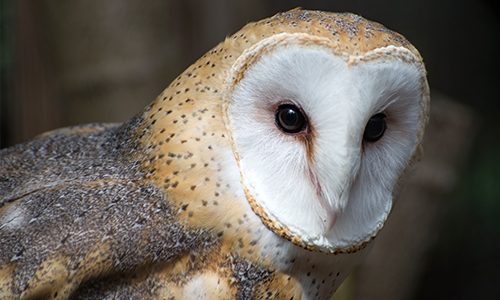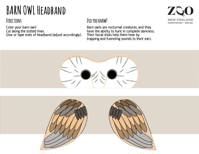Barn Owl
Tyto alba
About the Barn Owl

Geographic Range:

Class: Bird
Order: Strigiformes
Family: Tytonidae
Genus: Tyto
Species: alba
Barn owls are found on all continents except Antarctica. These birds of prey have distinct adaptations that make them successful nocturnal hunters. Their eyes are large to allow light in and, unlike human eyes, can't move inside of the eye socket. Owls instead turn their heads up to 270 degrees. Barn owls have ear holes on the side of their facial disk that allow them to hear what's happening below and above them, which comes in handy for night-hunting. The owl's facial disk is designed in such a way to channel sound directly to its ears, much like a satellite dish.
Barn Owl Facts
Appearance:
This owl is long legged with a white, heart-shaped face formed by a stiff facial disk. Owls have dark eyes and lack ear tufts. Their upper plumage is rusty or golden-buff with un-streaked whitish or pale cinnamon underparts. Their backs have visible lighter spots, and they have darker spots on their chest and belly. Males have whiter chests than females. Barn owls' soft plumage and fringed wing feathers help muffle the sound of their feathers when flying, allowing them to silently stalk prey.
The owl has exceptionally keen hearing and eyesight, making it an effective hunter. It can see during the day, but its eyes are forward-facing (like binoculars) and are better adapted for night vision. Like all owls, they can't move their eyes within their eye sockets, instead rotating their head to focus on different locations.
Owls' ears are asymmetrically located under feathers on the sides of their head; one is level with the nostril and the other is higher, nearer the forehead. The owl's ability to locate prey by sound alone is the best of any animal that has ever been tested.
Size:
- 13 - 14 inches tall, wingspan of 38 - 44 inches
- Females are larger than males, averaging 20 ounces in weight, and males average 16 ounces.
Diet:
These carnivores eat mostly small ground-dwelling mammals like mice, moles and voles.
Reproduction:
There’s no specific breeding season for these owls; it’s dependent on the available food supply. Barn owls are generally monogamous (one mate). They're sexually mature at 1 year of age and, because they have a short lifespan, they breed only once or twice. They can have one to three clutches per year, depending on the climate. In Massachusetts, courtship behavior usually starts around March, and eggs can typically be expected one month later. Nesting period lasts 50-55 days, with incubation taking 29-34 days.
Females typically lay between two to 18 eggs over several days, a process known as asynchronous hatching. Eggs are approximately 1.5 inches long and 1.3 inches wide. They are laid in tree cavities or available nesting sites like barns (earning this bird its namesake) or abandoned buildings. Nests are generally used repeatedly by other barn owls.
Chicks hatch helpless and covered in white down. Young are fledged (develop wing feathers large enough for flight) at three months.
Behavior:
Barn owls are solitary, except for breeding. Pairs are monogamous and often mate for life. They are territorial of their nest sites, but not hunting grounds. Males solicit females through vocalizations, mating flights, and nest acquisition.
Nocturnal creatures, these owls have the ability to hunt in complete darkness. Their facial disks help them hear by trapping and funneling sounds to their ears. One ear is located slightly higher than the other. This allows the sound to arrive a split second apart between the two ears, enabling the owl to better locate the sound’s source. These owls do not hoot; they instead screech and scream. They also make clacking noises with their beak while shaking their head as if to say “no” as a threat display.
They are nearly silent in flight, flying low and slow over open ground, listening for prey.
Owls are effective predators in controlling pests, often to their own detriment. Sadly, barn owls often die from eating poisoned rodents.
Habitat/Range:
Found in open habitats such as marshland, grassland, agricultural fields woodlots, etc. on six of seven continents, excluding Antarctica.
Median Life Expectancy:
Two years in the wild
Threats:
Barn owls are threatened by habitat loss due to urbanization and modern farming practices which affect suitable nesting sites and feeding grounds. Pesticide poisoning and vehicle strikes are additional threats.
What you can do:
Install nest boxes on your property well before breeding season, with guards to deter predators.
Fun Fact:
Barn owls are said to be able to hear a mouse’s heart beat from 90 feet away.

You Can Find This Animal in the Franklin Farm
Viewing Tip
Owl-spotters, look up! Franklin Farm's resident barn owl can be found ruling the roost in the barn's overhead perch.
You May Also Like
At Franklin Park Zoo:
At Stone Zoo:


